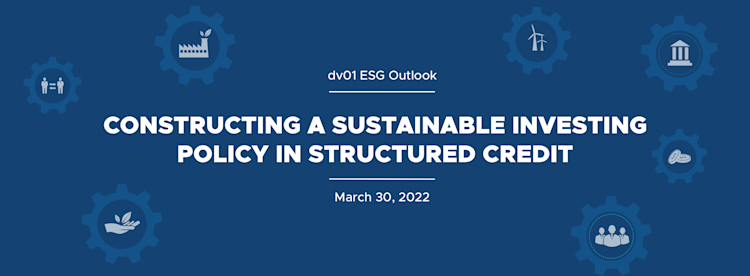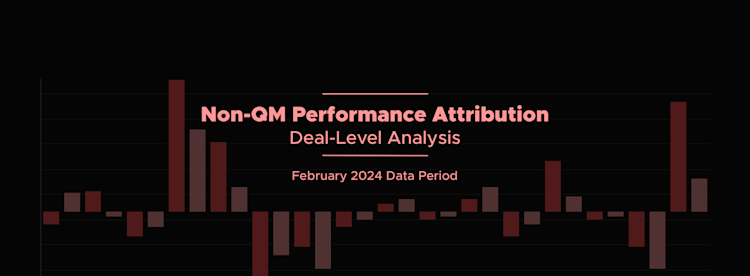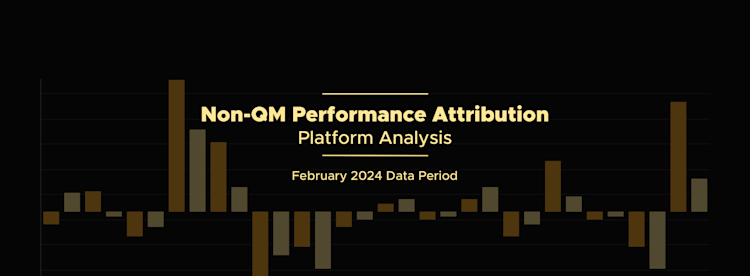Research
Constructing a Sustainable Investing Policy in Structured Credit
30 March 2022

Evidenced by the rapid growth of ESG investing and the growing corporate focus on sustainability, the investment landscape is changing for all market participants. Asset owners are emphasizing ESG issues, influencing how corporations consider sustainable business practices, and as the industry continues to evolve, both investment firms and corporations need to consider, evaluate, and refine their approach to environmental, social, and governance initiatives. Additionally, as the scientific community continues to sound alarm bells on climate change, investors must acknowledge that environmental risk is investment risk, necessitating the evaluation of environmental factors in the investment process. Market participants should document their approach to ESG issues and formalize them in an ESG policy.
dv01 has examined a variety of ESG policies, which range from basic regurgitations of the six UN Principles for Responsible Investing (“UN PRI”) to 50-page tomes describing the minutiae of proxy voting procedures and engagement strategies. This paper addresses best practices in ESG policy adoptions for all asset classes and considers methods to ensure structured credit investing adheres to internal guidelines, covering all aspects of investing, from screening to purchase to sale.
The Current Challenge with ESG Policies
Because sustainable investing began in equities, current ESG policies tend to be equity centric. While not all equities are the same, they are similar enough to apply the same methodology across the universe. Unfortunately, fixed income securities have idiosyncrasies that do not allow for direct translations of the same policy, such as different legal structures, instruments, and borrowers. Structured credit shares those same challenges while adding other complications. According to a UN PRI survey, the most common tactic for sustainable investors in structured credit is exclusion (i.e. denying capital to companies with unethical practices), leaving the industry decades behind the equity markets, which has matured well beyond this infancy stage.
Capital markets have tried simplifying an approach to sustainable investing by introducing “labeled bonds,” such as green, social, and sustainable bonds. However, the labels do not necessarily mean those bonds will align with a firm’s internal ESG policy. Furthermore, the label does not automatically eliminate the possibility of greenwashing due to inconsistent classifications and disparate reporting processes across securities, especially as issuers attempt to obtain “greenium” pricing for their securities.
Building an ESG Policy
Step 1: Defining ESG
While the extremes mentioned are likely ineffective (either too broad or too prescriptive in an ever-changing environment), effective policies should start with a sincere alignment of investors’ goals, values, and investment philosophy. This initial step should define what ESG and sustainability mean, which provides investors an initial yardstick to measure the current ESG factors in their portfolios. This is vital given the cliché that ESG means different things to different people.
When identifying goals and values, investors need to determine their preferred implementation techniques and strategies. Some investors prefer to simply exclude certain industries or sectors, while others look to integrate all ESG factors into their analysis and position their portfolios accordingly. In other words, ensuring ESG factors are priced into their positions. Others embrace impact investing, looking for societal return in addition to a financial one.
A thorough policy will define its scope, including across asset classes and geographies; implementation guidance; reporting requirements for internal and external accountability; and regular reviews of the policy to assess its relevance and internal compliance to it. Importantly, the policy needs to be flexible as ESG data becomes more standardized and formalized. These ESG-related data sets can paint a clearer picture of risks and opportunities associated with specific investments.
Step 2: ESG Implementation
The initial phases primarily take place pre-investment: choosing investments to avoid/target and sizing positions within a portfolio. However, that is not the end of the investment journey, nor the end of ESG analysis. Investors need to monitor the ESG performance just as they would monitor the financial performance. Investment fundamentals can change just as abruptly as ESG profiles (e.g., the Volkswagen emission scandal). The policy should dictate ongoing monitoring as it relates to ESG issues and recommended action should an investment fall out of internally determined eligibility. The policy should dictate if ineligible securities should be sold and determine the timing of the exit and/or engagement practices to ascertain the potential to rectify compliance with the policy. And while engagement and stewardship present unique challenges in fixed income due to the lack of voting ability, they can still be used as an effective ESG strategy.
Step 3: ESG Reporting
Finally, a thorough ESG policy should outline reporting guidelines for internal and external parties to provide accountability. This transparency will enable the evaluation of the efficacy of the policy and the ability to monitor alignment with internal policies and procedures. Loan level data is a key component of evaluation, giving asset owners the information that is vital to assessing changes to portfolios.
Why Loan-Level Collateral Data is Foundational to an ESG Policy
Just as investors have policies and procedures to evaluate investment opportunities, they must also craft a policy tailored to securitized products. Ideally, the policy can be applied across asset classes while maintaining a consistent approach to ESG evaluation. The UN PRI acknowledges the challenges structured credit investors face due to the diverse collateral and numerous nonhomogeneous borrowers, stating that “the availability of adequate ESG data represents the main challenge to investors incorporating ESG factors in their securitized product credit assessments,” and also notes a lack of securitized products coverage by ESG information providers.
While granular ESG data may be scarce at the moment, it is not impossible. dv01’s ESG Impact Intelligence eliminates these problems by adding loan-level data to securitizations, facilitating a similar approach to ESG analysis across asset classes, and can help investors beyond the pre-investment stage by offering insight into how the pool’s composition changes over time. Our proprietary technology enables us to integrate third-party datasets with individual loans, which offers investors actionable insights into their ESG profile, as well as identify opportunities. As ESG data goes mainstream, market participants must familiarize themselves with alternative datasets to uncover hidden value, drive wider acceptance of ESG standards, and drive further innovation within the industry.
Receive the Latest Insights
Subscribe to our mailing list to stay up-to-date with the latest market insights and product updates.
Subscribe to Newsletter

